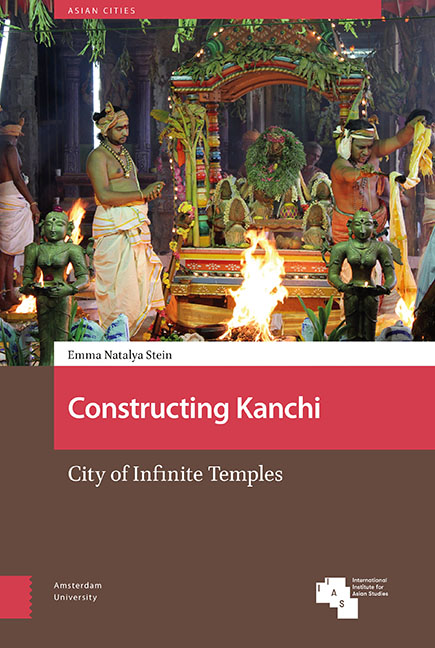Book contents
- Frontmatter
- Dedication
- Table of Contents
- Acknowledgments
- List of Illustrations
- Note on Transliteration, Translation, and Illustrations
- Introduction: All Streets Lead to Temples
- 1 Sandstone and the City: Building Pallava-Kanchi (ca. seventh through ninth century)
- 2 Realignment: Kanchi in the Chola Era (ca. tenth through thirteenth century)
- 3 The City and its Ports
- 4 Kanchi Under Colonialism
- Epilogue: The Living Temple
- Bibliography
- Index
Introduction: All Streets Lead to Temples
Published online by Cambridge University Press: 16 December 2021
- Frontmatter
- Dedication
- Table of Contents
- Acknowledgments
- List of Illustrations
- Note on Transliteration, Translation, and Illustrations
- Introduction: All Streets Lead to Temples
- 1 Sandstone and the City: Building Pallava-Kanchi (ca. seventh through ninth century)
- 2 Realignment: Kanchi in the Chola Era (ca. tenth through thirteenth century)
- 3 The City and its Ports
- 4 Kanchi Under Colonialism
- Epilogue: The Living Temple
- Bibliography
- Index
Summary
On the northern border of the city of Kanchi stands the sprawling temple complex of Ekāmbaranātha. Shaded lakes and dense, jungly groves fringe the walled compound to its north and west, and a soaring gopura (‘gateway’) marks the main passage into the sacred space from a street on the southern side. Leading directly to the temple, this busy commercial street is lined with sweet-sellers, tea stalls, and merchants selling the city's famed goldand- purple silk saris (Ill. 1). Some vendors have semi-permanent stalls set up along the street or built into maṇḍapas (‘pillared halls’), while others are itinerant peddlers who hawk their wares from movable carts. Between the shops are the houses of priests whose families have maintained the Ekāmbaranātha temple for generations. Closer towards the gopura, ladies sell garlands of jasmine and trays heaped with fresh lotus blossoms, coconuts, and bananas to be given as offerings to the gods inside the temple. From the early hours of the morning, the bustling street swells with auto-rickshaws, cars, buses, and all manner of vehicles carrying the thousands of visitors who arrive at Ekāmbaranātha each day. By nightfall, the temple traffic slows, the merchants cover their goods and close their shops, and the street returns to its local residents.
When Xuanzang, the famous Chinese monk and traveler, visited Kanchi in the middle of the seventh century, he praised the city as a prosperous urban center surrounded by fertile paddy fields and filled with learned priests tending hundreds of sacred buildings. The city's many temples greatly impressed this well-traveled Buddhist pilgrim. It is perhaps ironic, then, that Xuanzang visited Kanchi a century before its construction as a temple-city had even truly begun. During the eighth through thirteenth century, Kanchi served as the royal capital for two major South Indian dynasties – the Pallavas and then the Cholas – and was home to thousands of priests, literati, and landholding elites. The rulers and residents who dwelled in and around the city during these formative centuries sponsored the construction of more than 50 stone temples that still stand in varying states of preservation today (Ill. 2).
- Type
- Chapter
- Information
- Constructing KanchiCity of Infinite Temples, pp. 25 - 42Publisher: Amsterdam University PressPrint publication year: 2021



